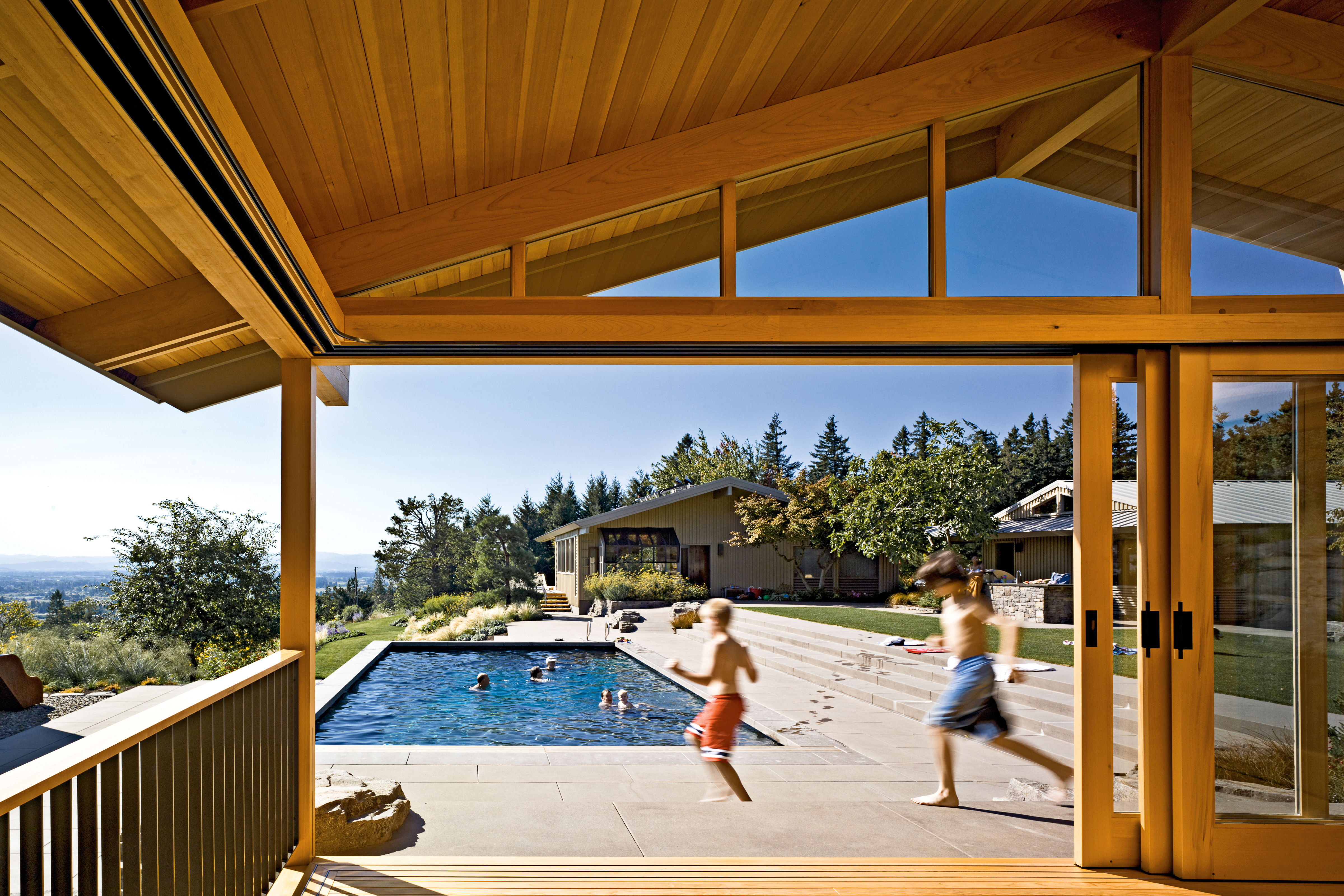Chic Revival
Homes painted in rich reds, light greens, sunny yellows, and even magenta strut their hues up and down the streets of Southeast Portland. But on the corner of one such street, a dark gray house sets an elegant tone in the otherwise boisterously colored block. Perfectly poised above the sidewalk, the house sits just beyond a lush welcome mat of plantings. Inside, the glass bubbles of a chandelier hang from the ceiling, their reflections twinkling on the glossy black floors and interior trim, crisply contrasted by white walls and cream furnishings. On warm summer nights, dinner guests refill glasses of wine in the kitchen and drift through French doors to talk under cherry trees, surrounded by the scent of yellow roses.
This idyllic portrait of domestic glamour bears little resemblance to the house as it was just a few years ago. “It was a real fixer,” says Portland-based interior designer Jessica Helgerson. “The kitchen was hopeless, the entry was ill-defined, the walls were peeling, and a drop ceiling over the stairs made it feel oppressive. It also had no backyard.” What the 2,400-square-foot home did have was great light flowing through large windows, the wonderful bones of a traditional 1908 Portland foursquare, and an idyllic location in a walkable neighborhood of coffeehouses and tree-lined streets.
For the renovation, the homeowners hired Helgerson to achieve a delicate balance between modern and hip while remaining true to the home’s century-old style. In other words, “to be as respectful of the house as possible without being stodgy,” Helgerson says. “I think my aesthetic is clean and uncluttered, yet different from one project to the next. It’s about listening to clients and also doing the right thing for the structure of the house.” Helgerson brings 17 years of design experience to each project, working with clients every step of the way—from drawing construction blueprints to specifying Sheetrock size and selecting paint colors and furnishings. Her choices have a sustainable slant as well: she considers the longevity of materials, uses FSC-certified wood and double-glazed windows whenever possible, and aims for timeless design—the kind that “the next homeowner won’t rip out.”
The first thing Helgerson did for this project was open up the floor plan by targeting the kitchen. A haphazard affair, the original kitchen was made of three small rooms: the sink sat in a butler’s pantry along with some original cabinetry, the fridge and range were in another room, and a mudroom adjoined the pantry. A butcher-block island on wheels was the only concession to food preparation, and mustard-yellow walls and cracked red linoleum were the finishing touches.
To create an area conducive to cooking and entertaining, Helgerson knocked out the walls between the three rooms, transforming it into one large space. She also removed the wall separating the kitchen and dining rooms, instead installing floor-to-ceiling glass cabinetry with a four-foot-tall arch in the middle. The effect is luminous and sculptural, as the glass and dishware within the cabinets become art objects on display. It’s also practical, making it easy to reach for an extra plate from either room.
Helgerson replaced a small door leading to the exterior with large French doors that open onto the backyard garden. When the homeowners first moved in, this was a driveway. They had it removed, and now blueberry bushes, pole beans, chard, and a persimmon tree grow in ground that used to be covered by concrete. All of the kitchen cabinetry is painted with Benjamin Moore’s Mascarpone, a warm shade of white, and the countertops are made of polished Carrera marble, whose gray hues and golden veins absorb the sunlight and reflect brilliantly off of the original Douglas fir floor that Helgerson found buried beneath the linoleum.
In the living room, Helgerson stripped off the mosaic surrounding the fireplace, revealing a brick underlay that she simply cleaned up and sealed, then topped with a stained alder mantel. Low bookshelves now flank the fireplace, illuminated from above by light that pours in through two new leaded windows; they were created by a local artisan to match the vintage windows by the house’s front entry. To divide the entryway from the living room more distinctly, Helgerson framed in the living room and created two low ledges that also provide additional seating.
The feeling of openness in the house is further enhanced by the colors and trim. “Before, you were going from a red room into an orange room into a blue room,” says Helgerson, pointing out the visual discontinuity of that progression. “Now, you always feel like you’re in the same house.” Wood trim was added throughout the house, and the ceilings were coved as appropriate to the home’s architectural vintage. A tricky crosshatching of box beams was added to the dining room ceiling, and tongue-and-groove paneling now embellishes the kitchen ceiling.
Helgerson had all of the wood stained ebony, including the floors, so that the glossy detailing shines through every room. To offset the dark trim, she painted the walls in Mascarpone—a signature Helgerson move. “I’m interested in contrasts: fresh, modern fixtures in an old house; dark rooms opening into light rooms; rough materials against polished ones,” she explains. “I like to create a feeling of surprise as you walk through a space.” Continuing the contrast, she covered the furnishings—all vintage or custom designed—in shades of white, with varied textures of sheepskin and tile inlay to keep it interesting. A sprinkling of silver-plated perforated lamps throughout the house shoot rays of light onto the walls, transforming what is a cheerful, sunny house by day into an elegant and moody space at night.
Indeed, few vestiges of the house’s former self remain. “The house is happier,” says Helgerson. “It’s now a chic, glamorous house that works really well.”





